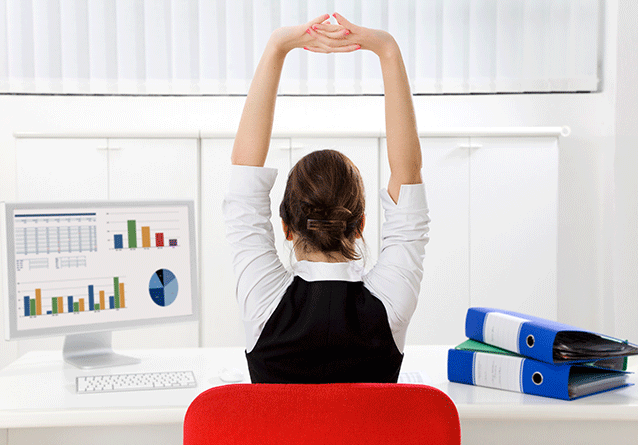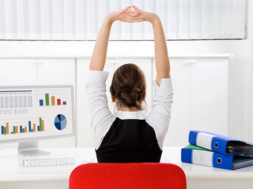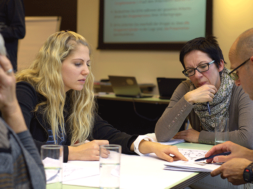
Tips and Tricks for Working from Home Successfully
By Rebecca Carpenter, PT, NMD, Director, Physical Therapist Assistant Program, Pima Medical Institute Mesa, Arizona Campus
We find ourselves several months into a worldwide pandemic and many college and university staff and their leadership are still working remotely. Having the right set-up for you and your staff is imperative for continued productivity. Moreover, as we find ourselves in front of the blue lights of our laptops, monitors, tablets and smartphones, making the time to look away for a few minutes to take a walk in the neighborhood or do some simple stretches may not be happening. Little “tweaks” to your at-home environment can keep you and your entire team working at your optimum capacity – no matter where you may be physically located.
When the COVID-19 crisis first began, many of us came home, put things down and got to work, not really considering if the work-from-home environment we had created was something that could be sustained.
When it comes to working from home or anywhere for that matter, a proper setup is very important. A properly planned home office environment helps bring normalcy and productivity into a situation.
Where a bad body posture can reduce productivity, a good body posture has several positive attributes on productivity. Working from home does not have to mean diminished productivity or physical problems.
For example, if your desk is not set up properly, you can get tension in your neck that can lead to headaches and other aches and pains. If we can set the desk area properly, everything else will fall in to place.
The computer is another primary piece of most home office environments. For those using desktops, many actually have their monitor set up too low. The top of the monitor should actually be level with your eyes. That being said, many of us also have reading glasses, if that is the case, you should lower that monitor between one to three inches depending on your preference so that you are not forced to constantly rotate your neck up and down throughout the day. Another common mistake people make is sitting too close to the monitor. We often have smaller work areas at home, but you should have your monitor at least arm’s length from you. Another common mistake is having your keypad too high. Your computer keyboard should allow your arms to be at about 90 degrees and straight out. Make sure to loosen your wrists and make sure you are not leaning on anything for support.
Another tip that many people do not think about is their chair height. I am approximately 5’4” and when I sit in a chair my toes generally touch the floor, but I cannot sit flat-footed. That is not optimum. To adjust for that, find a thick book or something like an apple crate or box to place under your feet, so that you can place your full foot flat and have your thighs at a 90-degree angle.
Now, because many people are also working on their laptops at home, here are some additional tips to consider. If you are working on a laptop, I highly recommend using an external keyboard and mouse. This way you can prop that computer up to the proper height. If the computer is on your lap or a table, try tilting the screen back slightly so that you do not have to strain forward to view your screen.
If you can, I also highly recommend investing in a standing table or a sit/stand converter for your desk or laptop. We have all heard the phrase that “sitting is the new smoking” when it comes to overall health. When working from home we do not always take enough breaks to get up and stretch our legs. When using your standing option, be sure to follow the tips above for monitor height, and do not forget about the external keyboard for laptop use. If you do use the standing desk option, it is actually best to move between sitting and standing. You should stand 30-45 minutes of every hour. Stand with your neck straight and make sure to relax your shoulders. You should wear supportive shoes (this is not the time to be in slippers!) and don’t lock your knees. Shift your weight back and forth or, if you prefer, use a small step and put one foot up on the stool. If you choose to use the small step, make sure you shift which foot is on the step every few minutes.
In addition, we cannot forget about our posture. Posture is one of the most important aspects of our workspace. Remember when working from home, or when headed back to our respective campuses and offices, to sit up straight. I recommend a desk chair with armrests that elevate. You should make a conscious effort to make sure your shoulders and head stay back. Do not hunch over! If you feel yourself hunching or slouching, take a minute to reset yourself and get back to work.
Having a proper home office is a good first step, but it is not enough. We must remember the importance of getting up and moving around throughout our day.
In fact, I recommend taking a quick break every hour. Yes, every hour.
Take a few minutes to walk around and do a little bit of stretching so you can get the blood flowing. Taking just a few minutes to reset and revive will make not only a difference for individuals, but it can also make for a more productive and clear-headed workforce.
You might be asking yourself, what can I do at home? Can I really stop every hour? There are plenty of stretches you can do at home and in your office, or on-campus once you return. And yes, you can stop every hour. You will be surprised how much a quick break to reassess and reset how you are feeling will help!
Think about how you are positioned in front of your computer. You are likely a little “hunched” with your shoulders rounded forward. Maybe your head is forward. That is not ideal and could cause issues in the future. We want to stop every hour and do some stretches. It is important to hold each stretch between 15 and 30 seconds for optimum results.
Below are some stretches you can do yourself and even share with your teams. You might even want to incorporate them as you all head back to in-person work environments.
The first stretch will help to loosen your neck. Start by tilting your chin toward your chest. You should feel a good stretch in the back of your neck, but no pain. Do that five to 10 times.
The next stretch involves dropping your head to the side, moving your ear toward your shoulder. Be sure not to move your shoulder to your ear, a common mistake. Repeat that on the other side. Do not neglect one side over the other.
Now, turn and look over your shoulder. You should feel a stretch, but no pain. Again, do these stretches for 15-30 seconds, repeating five to 10 times.
A great stretch for shoulders is a backward shoulder roll. They are ideal if you are sitting in front of the computer for long periods of time. Roll your shoulders backward about 10 times, rest and repeat 5-10 times. Remember; do not roll your shoulders forward, as that reinforces the poor posture.
One of my favorite stretches involves putting your hands behind your head and stretching your shoulders back. This is great for those of us who spend the majority of the day sitting in front of the computer. During this stretch, you might even find that your head begins to “clear” a bit and it could become easier to focus.
Finally, squeeze your shoulder blades together. This will help to open up your chest. It is important to remember to breathe when you are doing your stretches.
Speaking of breathing, we are all under more stress than normal and can sometimes feel overwhelmed.
A great tool to help ease some stress and calm down the body is the 4-7-8 breathing technique.
To begin, breathe in through your nose and hold for a count of seven. Then, exhale through pursed lips nice and slowly for eight counts. Anytime you are feeling stressed or need to take a moment to calm down, I recommend this breathing technique.
A great stretch to make sure your wrists stay loose involves putting your arms straight out in front of you. First, rotate your wrists in circles 5-10 times and then bring your wrists up and down 10 times to stretch the forearm muscles.
Taking time for yourself, easing stress and stretching are even more important in these unprecedented times. And, as the Director of the Mesa Campus’ Physical Therapists Assistant program, I see every day the impact our graduates have on people’s lives. As we all adjust to virtual environments, I am proud of the work my current students and faculty are doing and will continue to do.
Pima Medical Institute is an employee-owned, private, accredited school dedicated to providing students classroom studies paired with real-world training at medical facilities. Established in 1972, Pima Medical Institute helps students become career ready, focusing exclusively on healthcare professions, including medical, dental, veterinary and nursing fields. Curriculum includes certificate, associate degree and bachelor’s degree programs.
Pima Medical Institute operates 18 campuses as well as an extensive online curriculum. The medical career college has a presence in eight western states with the following ground locations: Albuquerque and Albuquerque West – Rio Rancho in N.M.; Tucson, Phoenix and two campuses in Mesa, Ariz.; Aurora, Denver and Colorado Springs, Colo.; Seattle and Renton, Wash.; Las Vegas, N.V.; Houston, El Paso and San Antonio, Texas; Chula Vista and San Marcos, Calif.; and Dillon, Mont. For more information and a complete list of programs offered at each campus, visit pmi.edu.
DR. REBECCA CARPENTER, PT, NMD earned her Physical Therapy degree from Virginia Commonwealth University and completed her degree in Naturopathic Medicine from Southwest College of Naturopathic Medicine. She spent many years practicing physical therapy in a variety of settings. She began teaching ten years ago, to give back to the profession and found her true passion. She is now the Director of the Physical Therapist Assistant Program for Pima Medical Institute and continues to have a small private practice.
Contact Information: Diane Smith // PR and Communications Manager // Pima Medical Institute // 480-320-0142 // dismith@pmi.edu // pmi.edu // Facebook: https://www.facebook.com/pimamedicalinstitute // Instagram: @pimamedical // Twitter: @PimaMedicalInstitute











